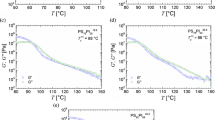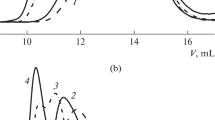Abstract
Rheological characterizations were carried out for two polystyrenes. One was a linear polymer with M w =222,000 g/mol and M w /M n =2, while the other was a randomly branched polystyrene with M w =678,000 g/mol and a broad molecular weight distribution. Experiments performed included oscillatory shear to determine the storage and loss moduli as functions of frequency and temperature, viscosity as a function of shear rate and pressure, and multi-angle light scattering to determine the radius of gyration as a function of molecular weight. The presence of branching in one sample was clearly revealed by the radius of gyration and the low-frequency portion of the complex viscosity curve. Data are also shown for three polyethylene copolymers, one (LLDPE) made using a Ziegler catalyst and two made using metallocene catalysts, one (BmPE) with and one (LmPE) without long-chain branching (LCB). While the distribution of comonomer is known to be much more uniform in LmPE than in LLDPE, the pressure shift factors were the same for these two polymers. The pressure and temperature shift factors of the two polystyrenes were identical, but, in the case of polyethylene, the presence of a small amount of LCB in the BmPE had a definite effect on the shift factors. These observations are discussed in terms of the relative roles of free volume and thermal activation in the effects of temperature and pressure.










Similar content being viewed by others
References
Arrhenius S (1916) The viscosity of pure liquids. Meddelanden Från K. Vetenskapsakademiens Nobelinstitut 3:1–40
Barus C (1883) Isothermals, isopiestics and isometrics relative to viscosity. Am J Sci 45:87–96
Eyring H (1936) Viscosity, plasticity, and diffusion as examples of absolute reaction rates. J Chem Phys 4:283–291
Ferri D, Lomellini P (1999) Melt rheology of randomly branched polystyrenes. J Rheol 43:1355–1372
Ferry JD (1980) Viscoelastic properties of polymers, 3rd edn. Wiley, NY
Ferry JD, Stratton RA (1960) The free-volume interpretation of the dependence of viscosities and viscoelastic relaxation times on concentration, pressure, and tensile strain. Kolloid Z 171:107–111
Hepperle J, Münstedt H, Haug PK, Eisenbach CD (2005) Rheological properties of branched polystyrenes: linear viscoelastic behaviour. Rheol Acta 45(2):151–163
Kim SO, (2000) A criterion for gross melt fracture of polyolefins and its relationship with molecular structure. Doctoral dissertion, Mc Gill University
Kim S, Dealy JM (2002) Gross melt fracture of polyethylene. II. Effects of molecular structure. Polym Eng Sci 42:495–503
Koran F, Dealy JM (1999) A high pressure sliding plate rheometer for polymer melts. J Rheol 43:1279–1290
Park HE (2001) Effect of pressure on the rheological properties of three polyethylenes. Master’s dissertation, McGill University
Park HE, Dealy JM (2006) Effects of pressure and supercritical fluids on the viscosity of polyethylene. Macromolecules 39(16):5438–5452
Plazek DJ (1996) Oh, thermorheological simplicity, wherefore art thou? J Rheol 40:987–1014
Podzimek S (1994) The use of GPC coupled with a multiangle laser light scattering photometer for the characterization of polymers. On the determination of molecular weight, size, and branching. J Appl Polym Sci 54:91–103
Williams ML, Landel RF, Ferry JD (1955) The temperature dependence of relaxation mechanisms in amorphous polymers and other glass-forming liquids. J Am Chem Soc 77:3701–3707
Wood-Adams PM, Dealy JM, deGroot AW, Redwine OD (2000) Effect of molecular structure on the linear viscoelastic behavior of polyethylene. Macromolecules 33:7489–7499
Wood-Adams P, Costeux S (2001) Thermorheological behavior of polyethylene: effects of microstructure and long chain branching. Macromolecules 34:6281–6290
Acknowledgements
We thank Dr. J. Kaschta for the GPC-data and Dr. J. Hepperle for providing the branched polystyrene.
Author information
Authors and Affiliations
Corresponding author
Rights and permissions
About this article
Cite this article
Park, H.E., Dealy, J. & Münstedt, H. Influence of long-chain branching on time-pressure and time-temperature shift factors for polystyrene and polyethylene. Rheol Acta 46, 153–159 (2006). https://doi.org/10.1007/s00397-006-0116-0
Received:
Accepted:
Published:
Issue Date:
DOI: https://doi.org/10.1007/s00397-006-0116-0




